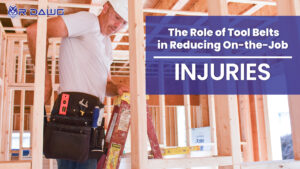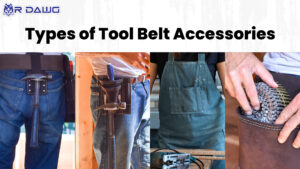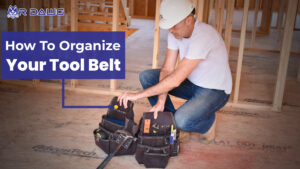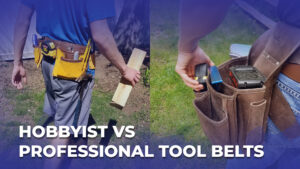
Father’s Day Gift Guide For Carpenters
Father’s Day is just around the corner, and it’s time to show appreciation for the man who has always been there to fix things around
We all know how important tool belts are in making our job easier and finishing work faster. They come in different styles and all of them can make any DIYer, carpenter, or professional contractor work efficiently with their tools.
However, there are a lot of cases wherein tool belts can put a serious strain on the hip and back when not used properly. According to OHSA (Occupational Safety and Health Administration), tool belts can weigh upward of 50 pounds if fully loaded. This puts significant pressure on the lower back and hips. Using a tool belt improperly can lead to a variety of strains and injuries.
The most common types of injuries associated with tool belts are back strains, shoulder strains, and hip problems. These injuries can occur due to carrying too much weight in the tool belt, using the tool belt for an extended period of time without taking breaks, and failing to distribute the weight evenly across both hips.
Just like what we do before a workout, stretching and warm-up exercises can help prevent strains and injuries when using a tool belt. Before beginning a physically demanding job, it is a good idea to take a few minutes to stretch and warm up your muscles. Stretching can help improve flexibility and range of motion, which can help prevent strains and injuries. In addition, warm-up exercises can help increase blood flow and prepare your muscles for activity. Some simple warm-up exercises that can be done before using a tool belt include arm circles, leg swings, and lunges. These exercises can be done in a few minutes and can help reduce the risk of strains and injuries while using a tool belt.
Arranging your tools properly in your tool belt can help prevent strains and injuries. When organizing your tools, consider the weight and size of each tool and try to distribute them evenly in the tool belt. It is also helpful to keep the heaviest tools closer to your body to reduce the strain on your muscles. It is important to avoid overloading your tool belt with too many tools, as this can cause imbalances and increase the risk of strains and injuries. It is also a good idea to rearrange your tools periodically to avoid using the same muscles repeatedly and to help distribute the weight evenly. When the tools are arranged or organized properly, this can also increase your efficiency when working.
Removing tools that are no longer needed from your tool belt can help prevent strains and injuries. When you are working on a project, it is easy to accumulate a large number of tools that you may not need. These excess tools can add unnecessary weight and bulk to your tool belt, which can lead to imbalances and increase the risk of strains and injuries. By regularly going through your tool belt and removing any tools you are no longer using, you can help reduce the weight and bulk of your tool belt and minimize the risk of strains and injuries. In addition, this will make it easier to find the tools you do need, as you will have fewer tools to sort through.
Wearing padded belts and suspenders can help prevent strains and injuries when there is too much weight in your tool belt. Padded belts and suspenders are designed to distribute the weight of your tools more evenly across your body, which can help reduce the strain on your muscles and joints. They also provide additional support and cushioning to help prevent discomfort and injuries. If you frequently carry a large number of tools in your tool belt, or if you are working on a physically demanding job, consider using padded belts and suspenders to help prevent strains and injuries.
Maintaining a good posture while using a tool belt is important in preventing strains and injuries. Poor posture can cause imbalances and put unnecessary strain on your muscles and joints. To maintain good posture while using a tool belt, try to keep your shoulders relaxed and avoid slouching or hunching over. Stand up straight and distribute the weight of your tools evenly across both hips. If you are working for an extended period of time, take regular breaks to stretch and move around. Being mindful of good posture when working can help prevent hip or back pains that are common among professional tradesmen.

Proper lifting techniques are important in preventing strains and injuries when using a tool belt. When lifting heavy tools or equipment, it is important to use your legs to bear the load, rather than your back. To do this, stand with your feet shoulder-width apart and bend your knees to lift the object. Keep the object close to your body and avoid twisting or turning while lifting. If the object is too heavy to lift safely, consider using a lifting aid or ask someone to help you. In addition, it is important to avoid lifting and carrying tools in awkward positions, as this can increase the risk of strains and injuries. By following these tips and using good lifting techniques, you can help prevent strains and injuries while using your tool belt.

Minimizing overhead work can help prevent strains and injuries when using a tool belt. Overhead work, such as painting, hanging drywall, or installing lighting, can be physically demanding and can put a lot of strain on your muscles and joints. If you need to do overhead work, try using a ladder or stool to reach the work area, rather than standing on your toes or stretching. This will help reduce the strain on your muscles and prevent injuries. If you must do overhead work while standing on the ground, try to use a stool or other support to help you maintain a comfortable, upright position. In addition, be sure to use proper lifting techniques and avoid carrying too much weight in your tool belt.
Taking breaks and switching sides can help prevent strains and injuries when using a tool belt. Wearing a tool belt for an extended period of time can put a lot of strain on your muscles and joints. To help prevent this, it is important to take regular breaks to stretch and move around. Taking a few minutes every hour to stretch and rest can help prevent fatigue and muscle strain. In addition, switching the tool belt from one side to the other can help balance the load and prevent imbalances that can lead to strains and injuries. Always remember, it doesn’t hurt to rest!
Choosing the right tool belt can help prevent strains and injuries. There are several factors to consider when selecting a tool belt, including size, weight, and material. It is important to choose a tool belt that fits snugly and comfortably, as an ill-fitting tool belt can cause imbalances and increase the risk of strains and injuries. Check out this tool belt buying guide so you’ll know what are the important factors you need to consider when choosing a tool belt.

In conclusion, using a tool belt properly can help prevent strains and injuries. By following simple steps such as choosing the right tool belt, wearing it properly, and practicing good lifting techniques, you can stay safe and comfortable on the job. Other important considerations include removing tools that are no longer needed, wearing padded belts and suspenders when necessary, being cautious of your posture, minimizing overhead work, taking breaks, and switching sides. In addition, stretching and warm-up exercises can help prevent strains and injuries by improving flexibility and preparing your muscles for activity. By following these tips, you can help reduce the risk of strains and injuries while using a tool belt.


Father’s Day is just around the corner, and it’s time to show appreciation for the man who has always been there to fix things around

The importance of safety on the job cannot be overstated. A safe work environment protects employees from harm, reduces the likelihood of workplace accidents, and

Tool belt accessories are designed to provide additional storage, organization, and convenience for workers, carpenters, and DIYers who need to carry tools and supplies on

A tool belt is an essential piece of equipment for many trades and DIY projects. A tool belt that is organized allows you to keep

Tool belts are an essential part of any construction project. They help you work more efficiently and safely while on the job. A tool belt

There are different types of tool belts. The tool belt is a fantastic item to carry all the necessary tools at hand. It is much
We asked 100+ professional carpenters, woodworkers, and construction workers to help you decide the best tool belt for you.